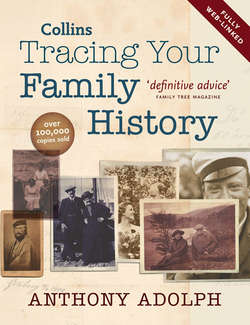Читать книгу Collins Tracing Your Family History - Ryan Tubridy, Anthony Adolph - Страница 28
ОглавлениеCHAPTER THREE ANCESTRAL PICTURES
Most of this book is about finding records of ancestors. Pictures can be records, too; even a photographer’s address on the back of an old snap could provide a clue as to where the depicted ancestor came from. But they are also valuable in their own right as a fantastic way of bringing your family history to life.
My cousin Ernest Rietschel of Dresden, a renowned German Sculptor, who was born in Pulsnitz in 1804 and died in Dresden in 1861.
Before the invention of photography in the 19th century, some of our ancestors were depicted in paintings, sketches, silhouettes and even busts and sculptures. From grand Van Dycks to amateur scribbles, such pictures are always worth seeking out, for, especially in family history, a picture really can be worth a thousand words.
WHERE TO SEARCH
PAINTERS AND PAINTINGS
For painters and paintings, look to M. Bryan’s Dictionary of Painters and Engravers (London, 1903–4) and F. Spalding’s 20th-century Painters and Sculptors (Antique Collectors Club, 1991).
The best places to make searches are in London at Westminster Central Reference Library, the National Portrait Gallery (which has a database of over 500,000 portraits and engravings), and the National Art Library at the Victoria and Albert Museum.
Of course, many ‘painters’ in the past were no more than jobbing artisans and many, such as engravers, herald painters and so on, appear in routine apprenticeship records. A detailed article on sources for artists and their subjects is in Family History Monthly, March 2003.
QUICK REFERENCE
WESTMINSTER CENTRAL REFERENCE LIBRARY
www.westminster.gov.uk/services/libraries/findalibrary/westref/
NATIONAL PORTRAIT GALLERY
www.npg.org.uk/search
NATIONAL ART LIBRARY
www.vam.ac.uk/page/n/national-art-library
Gainsborough’s famous family portrait of Mr and Mrs Andrews, c.1748–9.
PHOTOGRAPHERS AND PHOTOGRAPHS
Photography began in earnest in the 1850s and portrait photographs of people who became our ancestors took off in the 1870s. Collections of photographs are at county record offices, libraries and elsewhere, often enabling you to see what places where your ancestors lived looked like and, if you are very lucky, you might even find a picture of your ancestor.
WHERE TO SEARCH
PHOTOGRAPHERS AND PHOTOGRAPHS
The largest collection in Europe is the Hulton Getty Collection with a staggering 12 million pictures. The National Monuments Record Centre has 6.5 million pictures, mostly of buildings around the time of the Second World War, indexed by parish.
There are many commercial outlets for old photographs and reprints from old negatives, such as the Francis Frith Collection. There will often be a book of old photographs of the places where your ancestors lived.
There are also several excellent guides to dating old pictures, including R. Pol’s Dating Old Photographs (FFHS, 1998). Many other sources for pictures are listed in J. Foster and J. Sheppard’s British Archives: A Guide to Archive Resources in the United Kingdom (Palgrave, 2002). Another guide to collections is R. Eakins’ Picture Sources UK (Macdonald, 1985).
QUICK REFERENCE
HULTON GETTY COLLECTION
www.hultongetty.com
NATIONAL MONUMENTS RECORD CENTRE
www.english-heritage.org.uk/daysout/properties/national-monuments-record-centre
FRANCIS FRITH COLLECTION
www.francisfrith.co.uk
